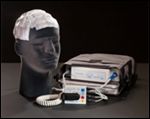First-in-Class Antimitotic Device Approved for Glioblastoma
The US Food and Drug Administration (FDA) has approved a portable noninvasive device, worn on the head, to treat adults whose glioblastoma multiforme (GBM) recurs or progresses following chemotherapy and radiation therapy.
The US Food and Drug Administration (FDA) has approved a portable noninvasive device, worn on the head, to treat adults whose glioblastoma multiforme (GBM) recurs or progresses following chemotherapy and radiation therapy.

VIDEO
Treatment mechanism of action
GBM, the most common primary brain cancer, is often resistant to surgery, radiation, and chemotherapy. In the United States, about 10,000 people are diagnosed with GBM annually. Median overall survival time from diagnosis is 15 months with optimal therapy, and median survival from the time of tumor recurrence is about 3 to 4 months without additional treatment.
The device, called the NovoTTF-100A System (Novocure, Portsmouth, NH, a subsidiary of Jersey Isle–based Standen Ltd.), weighs about 6 pounds and consists of an electric field generator, electrodes, and accessories. It can be powered with batteries for use outside the home, or plugged into an electrical outlet. Designed to be worn by the patient for at least 4 weeks continuously and until clinical disease progression, it is initially fitted by a healthcare professional. It is easily controlled by the patient and can be carried in an over-the-shoulder carrying case or backpack. The electrodes can be replaced with help from a caregiver.
Four electrically insulated disposable electrodes placed on the surface of the patient’s shaved scalp deliver low-intensity, intermediate-frequency alternating electric fields directly to the tumor site. These “tumor treatment fields,” or TTFs, exert physical forces on electrically charged cellular components of the GBM tumor, preventing the normal mitotic process and causing cancer cell apoptosis prior to division.
Specifically, the TTFs interfere with proper formation of the mitotic spindle during anaphase and cause intracellular dislocation of macromolecules and organelles during late telophase. The unique shape and electrical characteristics of dividing tumor cells make them susceptible to damage when exposed to TTFs. Most normal adult brain cells proliferate very slowly and are believed to be affected very little by TTFs. Also, the antimitotic effect of the 200 kHz TTF frequency has been shown to specifically inhibit replication of GBM tumor cells, while not affecting replication of other cell types, such as neurons.
FDA approval of the NovoTTF-100A System was based on the results of a single international clinical study in 237 patients whose GBM had recurred or progressed following traditional therapy. More than half of the patients were at their second or subsequent recurrence, and baseline tumors were large (> 5 cm in diameter).
Survival time in patients treated with the NovoTTF alone was comparable to that of patients treated with the physician’s choice of the best chemotherapy. Progression-free survival at 6 months was 21% in the NovoTTF group, compared with 15% in patients who received chemotherapy. Patients treated with the NovoTTF had a 14% tumor response rate, compared with a tumor response rate of 10% in the chemotherapy-treated patients. Three complete radiographic responses were observed in the NovoTTF group, but no responses were observed in the chemotherapy-treated group.
Patients in the NovoTTF group reported better quality of life scores and fewer side effects during the trial, compared with chemotherapy-treated patients, specifically in the domains of vomiting, nausea, pain, diarrhea, constipation, and cognitive and emotional functioning. The most commonly reported side effect from NovoTTF treatment was a mild-to-moderate rash beneath the electrodes.
Contraindications to use of the NovoTTF-100A System include an implanted medical device, a skull defect, or a known sensitivity to conductive hydrogels (eg, those used with electrocardiograms). The NovoTTF is not intended to be used in combination with other cancer treatment, and it should only be used in patients who do not respond to other treatments for GBM.
The NovoTTF-100A System is approved for marketing in both Europe and the United States, and there are plans to develop this therapy for use in “a range of other solid tumor cancers,” said Novocure’s Executive Chairman, William F. Doyle.
Novocure is sponsoring an ongoing pivotal trial of the NovoTTF device for patients with newly diagnosed GBM under an approved investigational device exemption application. Additional information is available at www.novocuretrial.com.
